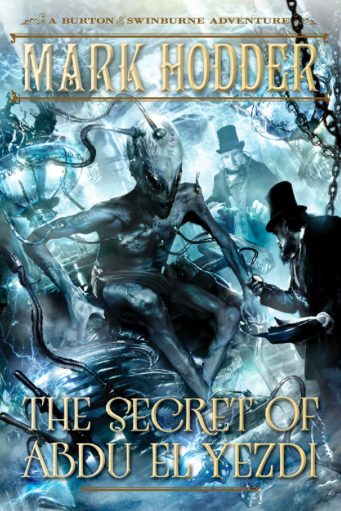Back in October I stated in a book review that I had two favorite authors I tended to recommend — George Mann and Mark Hodder. Between these two gentleman, I’ve got three different steampunk series that I’ve absolutely enjoyed over the years — and there are more books to come. (I’ll put some links at the end of this review to my previous reviews of their works.) Right now, Mark Hodder has just launched his latest trilogy, a follow-up series to his original Burton & Swinburne trilogy that began with The Strange Affair of Spring Heeled Jack, got deeper and darker with The Curious Case of the Clockwork Man, and wrapped up with Expedition to the Mountains of the Moon.
Let me be clear — while these books may lean to the steampunk side of fiction, anyone who enjoys a good slow burn of a fiction tale will absolutely enjoy these stories. The “steam” element is secondary to the overall plot of the original trilogy that finds the famous (real-life) adventurer Sir Richard Francis Burton and his (real-life) friend and poet Algernon Charles Swinburne caught up in a set of world and time-bending events that will make your head spin… in a good way.
While I’d like to try and avoid spoilers as much as possible, that’s going to be difficult here as I share with you some information about the first book in the new trilogy. So, that said… please stop reading now if you don’t want any details about the original trilogy or the newest book.
With the first trilogy, the world is quite different from the Victorian world we all know from our history books. This one is filled with amazing technologies that include clockwork men (automatons), steam-powered personal flying devices called rotor chairs, and other amazing inventions. The world has changed, and it is all because one man from the future has decided to change the past to repair his family’s name. The man known as Edward Oxford has created a special suit that allows him to go back in time to try and prevent an assassination that has stained his family’s reputation for centuries. And the results of that single time jump have not only altered time as we know it, but have also fractured time-space enough to allow for some very strange paranormal-like events and persons to grow in power and develop their own agendas.
The first trilogy is a whirlwind. If you enjoy a good time-travel story that tends to test your powers of logic, you’ll find that Hodder has created a story that may very well have you creating your own time map to keep it all straight. And where the first trilogy ends, the second trilogy picks right back up with the fallout from Burton’s attempt to repair the damage done to the timeline… with The Secret of Abdu El Yezdi. (Slight spoilers for this first book in the second trilogy ahead, so beware.)
Because of the attempted repair to the timeline, the current Richard Burton and company have all experienced The Great Amnesia, a three year period where the entire world has experienced a complete loss of memory. The explanation for this memory loss will be somewhat obvious to readers of the first trilogy, who were along for the ride as Burton’s final duty in The Mountains of the Moon was to try and fix the assassination attempt on Queen Victoria. Things didn’t go as planned.
Consider this second trilogy a sort-of reboot. While the world looks much the same as when the first trilogy began, there are many differences. A big one is the fact that the friendship between Burton and Swinburne doesn’t exist! Other key characters that were (or became) close to Burton and Swinburne are now unfamiliar but still manage to cross paths with the adventurer; in a few instances some characters have changed allegiances, so to speak, and some are even now found alive and breathing.
Time travel is not to be messed with lightly, and Hodder’s two trilogies make it readily apparent how one stray bullet, whether hitting or missing a target, can change it all. But once again, in The Secret of Abdu El Yezdi, Burton finds himself on one side of a secret war and a shadowy enemy known as Perdurabo on the other. Because of so many changes to the timeline, fragments of other histories are beginning to return to Burton in hazy visions and another mysterious figure named Abdu El Yezdi is coordinating events for his own agenda — will the future repeat itself or can Burton once again ally himself with the right individuals to prevent further damage to the timeline?
I reached out to Mark Hodder with some questions about the trilogy, the current book, and the rest of the series. You can read his responses below, but let me assure you that if you’re writing off the Burton & Swinburne stories because they might be labeled as steampunk, you’re really missing out. Not only has Hodder done some amazing world building here, but he’s created a mythology that is morphing from book to book as he twists and pulls the timeline with some creative interference from more than one key character. It’s been a fun ride… and it’s not over yet.
—–
Here are the links to my previous reviews as well as ten questions I put to Mark Hodder about these two trilogies. I’d like to thank Mark for taking the time to offer up some great responses:
Previous review of Burton & Swinburne books
James Floyd Kelly: While your books can certainly be considered steampunk, I’d probably first classify them as hard science fiction given the time travel elements you’ve woven in and the deviations with the true history. Are you okay with the Burton & Swinburne series being labeled as steampunk or would you prefer they be classified outside of that genre?
Mark Hodder: I consider genre as being the purview of marketing departments rather than authors. It dictates where books will be placed in bookshops and how they’ll be labelled for the convenience of shoppers. Of course, from an author’s perspective, genre trends might be taken as an indication of where money can be made (i.e. “Steampunk is hot, so I’ll write steampunk and my novel will fly off the shelves”) but in truth such an approach is doomed to failure because by the time you’ve written your novel and it’s gone through the painfully slow publishing process, the trend will have changed and your work will be seen as ‘old hat.’ For me, the concept of genre never goes beyond the fact that I like to write ‘speculative fiction.’ I don’t care to limit myself by any more specific classification than that. The Burton & Swinburne series is currently labelled “steampunk,” which is fine, but if it’s still being published ten years from now (fingers crossed), it’ll probably just be called “sci-fi,” which is also fine.
James Floyd Kelly: I’ve often wondered about your choice of Swinburne… Burton is an adventurous (and obvious) character who lends himself to fictional adventures, but I’m just curious how you fell on to Swinburne as his trusty partner?
Mark Hodder: It was very simple: they were very close friends in real life and I found the combination so Laurel & Hardy-ish (physically) that I couldn’t resist it. Also, I portray Burton as very internalised, so it worked very well to have as his companion someone who was exactly the opposite.
James Floyd Kelly: How much planning and outlining were required for you to keep all of the plot elements and characters straight through the current four books? The time travel stuff alone makes my head ache, but I cannot find a break in logic of the story — I’m just curious how you keep it all together and making sense.
Mark Hodder: Although a series-wide story arc has emerged, it wasn’t there from the beginning. Basically, with each novel, I’ve built on what has gone before; each book has raised further questions. By the time I was halfway through Expedition to the Mountains of the Moon, I knew where the wider story was going, so was able to begin planting seeds for the second half of the six-part ‘serial.’ Yes, you’re right, the tangled time travel is headache inducing. There’s been a high degree of “by the seat of my pants” about the whole project, but I think I’ve got away with it so far.
James Floyd Kelly: Spring-Heeled Jack figures into all the books, and it seems to me that there really is no un-doing of the damage he did to the timeline in the first book… or is there?
Mark Hodder: You’ll have to wait and see. He returns to the forefront of the story in The Return of the Discontinued Man … and I have a cunning plan.
James Floyd Kelly: I’ve already seen the cover for the next book, and I’m grinning wide that you’re not done with Oxford — so happy to hear that Spring-Heeled Jack is going to make another appearance. Was that always your plan? Just how much more “tinkering” with the timeline do you have left to tell?
Mark Hodder: After The Return of the Discontinued Man (which is the fifth), there’s one more Burton & Swinburne to go. A six-part story arc divided into two trilogies. It wasn’t always my plan for Edward Oxford to make a return appearance but by the time I was at the midpoint of the series I knew he had to, both from a storytelling perspective and also in terms of what the readers would want at this juncture. The ‘tinkering’ in Discontinued is intense, though not in the manner you might expect, and the outcome is another of those “how the hell will Hodder get Burton out of this?” moments.
James Floyd Kelly: In your most current book Burton & Swinburne book (The Secret of Abdu El Yezdi), you basically pressed the Restart button on history and Burton no longer has a history with so many of the other characters in the first trilogy, the most shocking being no knowledge of Swinburne (initially). Was it difficult to keep track of all the other characters that Burton did and did not cross paths with at various times?
Mark Hodder: No, it was more a case of “who should reappear and in what guise?” This continues in Discontinued, which has a number of major and minor characters from the first two novels popping up. Consider this question: if you had lived your life differently—if, for example, when you were 18-years-old you had turned right instead of turning left and the consequences of that decision led to utterly different circumstances—would you now be surrounded by the same people? Logic says no, probably not. However, if the people around you are somehow extensions of yourself (and you of them), and if there’s any component of “Self” that endures whatever the circumstances, then the same people most likely would be there. This odd conception will become meaningful to Burton at the climax of the series.
James Floyd Kelly: One technical question that I’m still struggling with — Brunel still has the black diamond fragments that hold his personality. I thought the black diamonds were “removed” or somehow eliminated from the current history based on the actions in the original trilogy. What did I miss that allows for Brunel to still exist in his current state but doesn’t bring back all troubles (such as the ancient race) into the current timeline?
Mark Hodder: In Mountains of the Moon, Burton collects the diamonds and is manipulated into eliminating the lizard consciousness from them. This elimination, through resonance, extends backwards, forwards and sideways through history (if this isn’t clear in Mountains of the Moon, it is clarified in Discontinued Man). A paradox! Now Burton never needed to do any of what he has just done! He then takes the diamonds with him back through time and unwittingly creates a new offshoot of history (and since the diamonds already exist in the past, they are now doubly present in this new history). Fragments of the “cleansed” diamonds are then used to preserve Brunel’s mind. That’s your technical question answered. However, I want to add this: the business of an “ancient reptilian race” and their manipulations and self-annihilation, together with Burton’s “reboot” (all of which occurs in the depths of the arc’s midpoint), is me purposely creating a symbolic undercurrent in the story arc the significance of which may not become clear (if at all, depending on each reader) until the series can be viewed in retrospect, and even then perhaps not intellectually. Symbolism is weird and ungraspable.
James Floyd Kelly: Queen Victoria is still dead in the current timeline, and it’s that event that seems to be the turning point for changes between our history and the new history. Have you locked in this death to your overall story or do you have intentions of returning history to its correct version? (It might mean the end of your series, so I’m not sure I would want you to do that!)
Mark Hodder: Sorry, no spoilers! The only thing I’ll say is that Queen Victoria makes a very significant appearance in Discontinued Man.
James Floyd Kelly: You included an apology of sorts in the third book that made me think you might have received complaints about how some historical figures were portrayed (many as villains). Did some readers actually take issue with your manipulation of so many real-life persons?
Mark Hodder: No, not a single one. It was just a case of me feeling guilty for hijacking some of my “heroes of history” then twisting them into grotesque parodies. I have, however, had a great deal of feedback from readers who, after completing my novels, researched the “real” people I featured and thanked me for introducing them to these incredible characters. This fact completely alleviates my little pangs of guilt.
James Floyd Kelly: The next book is titled The Return of the Discontinued Man, and while I think it refers to Oxford, I’m not so certain given that so many alternative histories have now been voided. Any hints on where the next book will take readers? And any hints on the third book (assuming this is a new trilogy)?
Mark Hodder: In addition to the hints I’ve already dropped? Well, yes, I can confirm that the Discontinued Man of the title is Edward Oxford aka Spring Heeled Jack. It might also refer to someone else. Actually, two someone else’s. Perhaps I should have called it Discontinued Men. I’ll also say that a lot of time travel is involved but I’ll not tell you in which direction. Lastly, where Discontinued Man is concerned, I’d claim this to be a very highly significant novel in terms of the wider story arc, and one that I hope will have my readers finishing it and thinking, “WTF?” As for book six, I haven’t a title for it yet but I know the overall storyline and I’ve written the first chapter. If you set out looking for a solution to the WTF ending of the fifth book, you’ll find that the sixth starts with an even bigger “WTF?” But, you know, if I’m F-ing with your expectations, then I must be doing my job right, hey?









Thanks for this interview. I’ve been enjoying these books for the last few months – and was really happy to see the series continued.